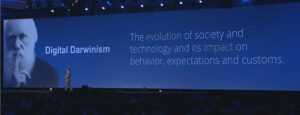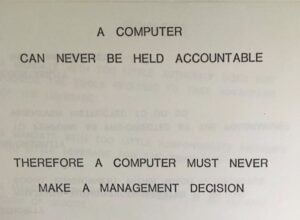
To celebrate the release of my new book, The End of Business as Usual, I recently hosted a discussion on behalf of Vocus on how businesses should rethink a marketing-driven social media approach by not just engaging, but activating a market-driven strategy defined by smarter, more meaningful engagement.
More than 1,000 people attended the event and while I tried to answer every question, many were left unaddressed because of time constraints. This post tackles some of the recurring questions we received on Twitter.
Q1: Whenever I hear about strategies, or when I present myself, I always get the feeling that Lewis Carroll said it best: “Would you tell me, please, which way I ought to go from here?” “That depends a good deal on where you want to get to,” said the Cat. “I don’t much care where…” said Alice. “Then it doesn’t matter which way you go,” said the Cat.
This particular question is unique in how it was presented, but it also reflects the sentiment of so many others who attended the event as well as those I work with every day.
I believe that businesses approach social media with the genuine intention of wanting to engage; however, many miss the tenets and dynamics of what makes social media, well…social. For example, social media is already siloed within most organizations today. The top three departments that “own” social media are marketing, marketing communications, and public relations respectively. When you study day-to-day programs, it’s clear that campaigns, contents, and conversations offer the semblance of engagement, but really add up to nothing more than meaningless platitudes.
Much of new media is just that: new. But businesses are diving into social media without a clear vision, mission or purpose. They are not thinking about the experience they wish to design, the emotions they desire to evoke, the click paths of those they engage, or the outcomes they seek.
In the absence of direction, think about engagement as an opportunity to close existing gaps between an organization and its stakeholders. To get these answers requires research, discourse, and intuition. Without answers or insights, what is this really about? It must mean more than simply creating social presences.
Q2: Are we no longer supposed to speak WITH an audience? What happened to interaction?
Interaction, conversations and responses contribute to dialogue and two-way engagement. Intention counts for everything here, but at the same time, engagement is measured by the sum of actions and words. If you study the nature of dialogue that’s taking place without you today, the ability to learn from existing activity inspires engagement strategies and content programs that deliver value. Some ask questions. Others need help or direction. Certain groups seek affinity or simply entertainment. The reality is that social media can cater to all of the above and more, yet strategies are limited in scope with value measured by soft metrics such as the number of Likes, comments, followers, retweets, views, etc. Engagement is not measured this way and anyone who tells you differently is wrong. I just can’t say it any other way.
Engagement is defined as the interaction between a consumer or stakeholder and an organization. It is measured – here’s the important part – as the take-away value, sentiment and actions that follow the exchange. Without definition, where will they go, what will they feel, what will they do or say?
Your job as a change agent is to create content so compelling that you empower others to ENGAGE, SHARE and TAKE ACTION. To put it simply, that A.R.T. of social media is in the actions, reactions and transactions you can shape and steer. This is why we are no longer merely engaging with an audience, but instead a sophisticated and connected audience with an audience of audiences.
Conversations and interaction is useful. But there’s a gap between what stakeholders or consumers expect and what businesses deliver against today in social media. Don’t just mind the gap – bridge the gap!
Q3: What is the marketing potential for Tumblr? Are consumers escaping the corporate feel of Facebook and Twitter?
Let me first say this, Tumblr is a unique network that is often misunderstood or underestimated by businesses. In terms of social media, Tumblr is third on the list of total minutes spent in social networks and blogs behind Facebook and Blogger according to Nielsen. Perhaps I should also point out that Twitter is in a not-so-close fourth position.
Tumblr is a hybrid social network and microblog community rich with its own culture. Some businesses look at Tumblr as an opportunity to further syndicate media in a one-to-many approach. For example, a post on Facebook is often published to Twitter and also Tumblr. Yet, Tumblr demands something new, dedicated and introduced within the culture code established by its fervent user-base. As it is also a social network, Tumblr requires more than just content publishing to successfully engage: it requires bona fide engagement outside of your page to cultivate relationships and a community.
Q4: Your social media examples seem skewed to B2C. What are the best practices for B2B?
Social media is not relegated to any industry. The benefits of smarter engagement know no bounds. However, smarter engagement, regardless of market or industry, requires research and an understanding of how people find and share information and also how they influence and are influenced by their peers. You’ll find that with B2B, information, direction, insights around challenges and opportunities, are bound by shared experiences. What’s different of course, are the networks and the nature of the interaction. Depending on the nature of the business, the top networks are usually not Facebook and Twitter – instead, they’re blogs, YouTube, and LinkedIn.
Companies focused on solutions for other businesses find that participating in conversations for the sake of conversations carry little value. Instead, delivering value or insights based on real-world challenges or questions helps decision makers make decisions.
For example, Indium, a global solder supplier specializing in solder products and solder paste for electronics assembly materials, studies how prospects search for solutions based on keywords. Rather than manipulate search results to send people to Web pages, the company invests in useful content to match keyword searches with value-added original content. The result? The company experienced a 600% spike in leads over the course of six months.
If you add video to the equation, there’s a reason that Youtube is the second largest search engine next to Google. People are using similar keywords to find results based on a video narrative. The question is, what are your customers and prospects searching for and what’s turning up in their results?
The social media revolution has given way to a new era of consumerism and consumer influence. As a result, the era of business as usual is over. As customers grow more confident and vocal, organizations are either listening and responding or turning towards the inevitable path of digital Darwinism – the evolution of consumer behavior when society and technology evolve faster than the ability to adapt. Meanwhile, fast-moving challengers are making huge gains through smart, meaningful customer engagement.
This is your time to lead, not follow.
Order The End of Business as Usual today…
Image Credit: Shutterstock






Brian, this was a great webinar. I’m excited to read the new book!
Thanks for being there Gabe…looking forward to your thoughts on the new book!
I love Tumblr. It is the most natural and logical of all the social media platforms that I have used.
I had my first blog on Tumblr a while back, the only problem I had with it was the feel of it. It was incredibly easy to set up and delete and it didn’t feel as permanent as a self hosted blog (Im on word press now) i didn’t have any desire to invest time in it as it felt so temporary. Just my opinion.
This is a good article and offer some helpful information for me,thank you!
Just added the book to my Amazon cart. Looking forward to reading it.
I am great fan of your blog.Every time i come here i see something very new.Thanks for sharing the information.
It’s a shame that Twitter is used so poorly. If you ask 10 people what they think about Twitter, probably 9 of them will say it is the domain of rock stars and teenagers. I routinely go back to my old Tweets to pick up an article that I found useful and forward it to someone. In so many ways it has become a repository of posts and landing pages that are flavored by the sender. So there is a personal touch to them (at least the good ones). Twitter has a bad rep and it’s just too bad. Anyway, great article. Gets me thinking. Keep evangelizing, Brian!
I used to use Tumblr for blogging purposes. I appreciate your explanation of how Tumblr can be used in the marketing world. Your book is now on my list of books to read!
It is the domain of rock star and teenagers.. I routinely go back to my old Tweets to pick up an article that I found useful and forward it to someone.
Can’t wait to apply the Tumblr marketing ideas. I think Twitter is invaluable for business.
This book rocks, this is why I get this. It is unusual for me to take few days to read a book, but the new
book by Brian Solis is one of those books you need to take nice and slow
to get all the nuances in it.
Many of us blindly follow a path in business with no passion, purpose or direction—we simply slip onto a moving walkway, like the ones at the big airports, which carry us along like the rest of the herd of people that are in a hurry to get someone. We ask no questions in our business—we are copy cats treading the walkway. Because we see how others are just having surface conversations in business, it must work. We haven’t got a clue if we are making a difference or not, creating happiness (for ourselves as well as others), or leaving a legacy that we would be proud of. We sense a lack of REAL connection to our clients, colleagues, and others, and realize there must be more. Instead we continue to communicate on the surface level and feel at a loss at what to do to change things.
Each of us must wake up from autopilot and from our state of unconsciousness in business. The great quote by Anne Morrow Lindbergh says it all, “When one is out of touch with oneself, one cannot touch others.”
Great, a lot of people now a days that fb & twiter is the best social networking site for business. I agree with you that its Youtube & linkdin. People Seek narrative video & instructional blogs. Thanks for giving more reality on social media marketing.
Nice Post.
Launch X431 GX3 Auto Diagnostic Tool 100Z